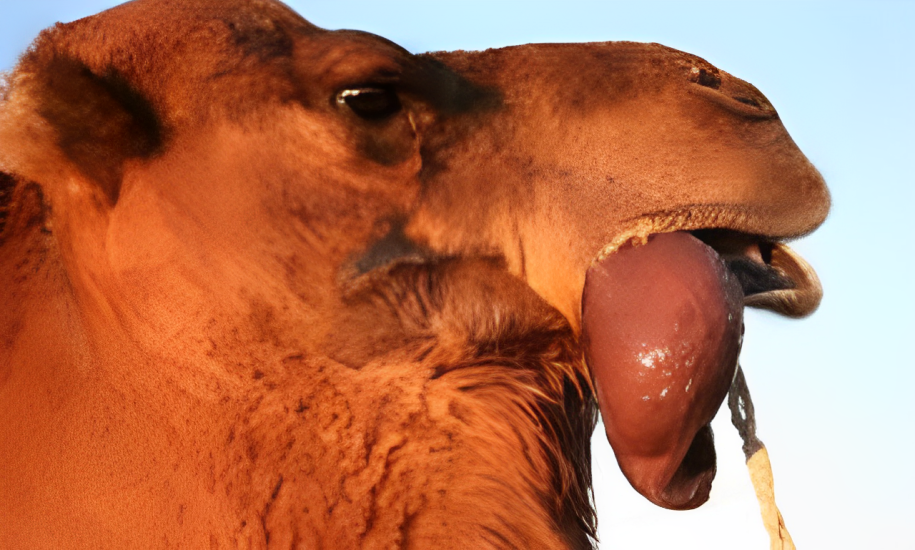Table of Contents
There’s something innately compelling about camels. These resilient, enigmatic creatures have long held a firm place in our collective cultural imagination. Yet, there’s more to them than meets the eye. To enhance your understanding, we have collated 48 top facts about camels. Dive in and prepare to have your mind blown by the rich tapestry that is camel life. Yes, it includes whether camels spit or not. So, let’s start!
Fact 1: Two Different Types of Camels
The camel world is primarily divided into two distinct species: the single-humped Dromedary and the double-humped Bactrian. Both types have adapted to live in harsh environments but in different ways.
Fact 2: Habitat Adaptation
Camels, including Dromedaries, have adapted to survive in extreme environments such as deserts and arid regions. They are found in regions of Africa, the Middle East, and Asia. Their adaptations help them withstand harsh climates and scarcity of food and water.
Fact 3: Camels Humps
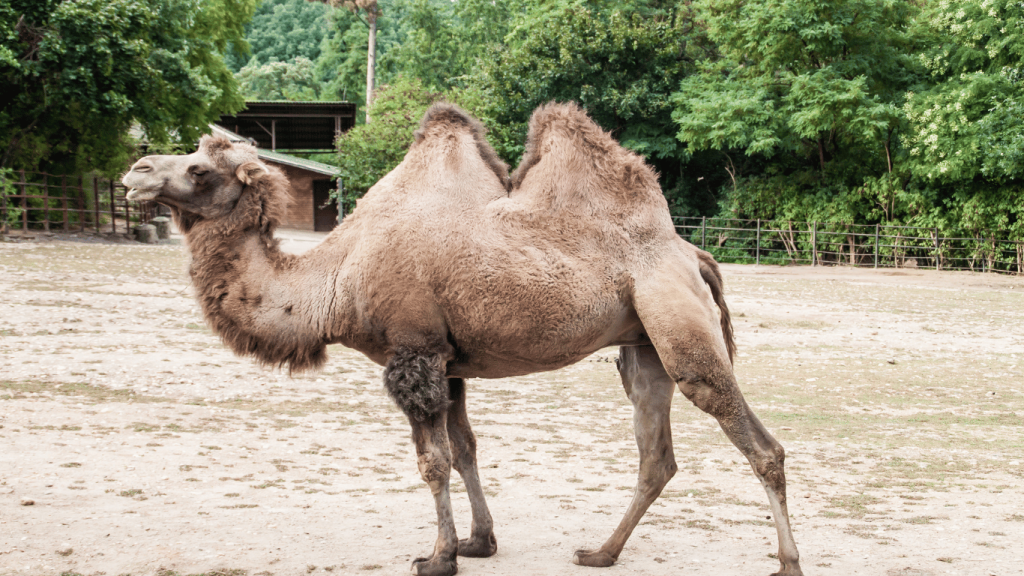
Contrary to common belief, camels’ humps do not store water. Instead, they store fat, which the camel can metabolize for energy when food is scarce.
Fact 4: Long Lifespan
Camels have a relatively long lifespan, typically living between 40-50 years. Their longevity is a result of their hardy nature and their ability to endure harsh living conditions.
Fact 5: Camel Milk
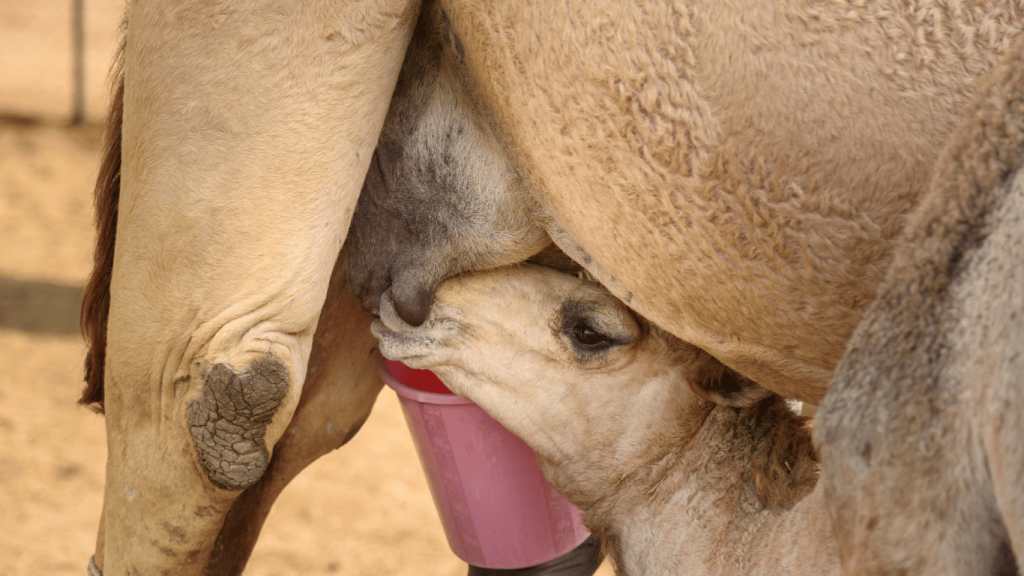
Camel milk is a highly nutritious food source, packed with vitamins and minerals. It is a staple food in many desert cultures and is often considered superior to cow’s milk.
Fact 6: Unique Blood Cells
Camels have oval-shaped red blood cells, unlike most other mammals whose blood cells are round. This shape enables camels to continue circulating blood even in a dehydrated state.
Fact 7: Camels in the Wild
While most camels are domesticated, there are a small number of wild Bactrian camels in China and Mongolia. These creatures are critically endangered, with only a few hundred left in the wild.
Fact 8: Body Temperature Regulation
Camels can regulate their body temperature, allowing them to withstand temperature fluctuations. This ability to tolerate extreme temperatures is vital in desert environments.
Fact 9: Incredible Water Storage
When it comes to hydration, a camel exhibits an astounding capacity, consuming roughly 30 gallons of water in a short span of around 13 minutes. Their bodies can rehydrate faster than any other mammal, a crucial adaptation in their arid habitats.
Fact 10: Camel Gestation Period
The gestation period for a camel is around 13-14 months, and usually, only one calf is born. These baby camels are born without a hump but will develop one as they start eating solid food.
Fact 11: Their Unique Gait
Camels have a unique gait called ‘pacing.’ They move both legs on one side of their body at the same time, giving their walk a swaying motion. This is why they’re often referred to as the “ships of the desert.”
Fact 12: Historical Importance
Camels have played a crucial role in history and trade, especially on the Silk Road, where they were used as pack animals for transporting goods and facilitating camel trekking journeys across vast distances. Their ability to travel long distances without water made them invaluable.
Fact 13: Camel Fur

Camels have a thick coat of hair that protects them from the sun’s rays during the day.
Fact 14: Camels’ Eyes and Eyelashes
Camels have three eyelids and two rows of eyelashes, which protect their eyes from blowing sand and dust.
Fact 15: Unique Foot Structure
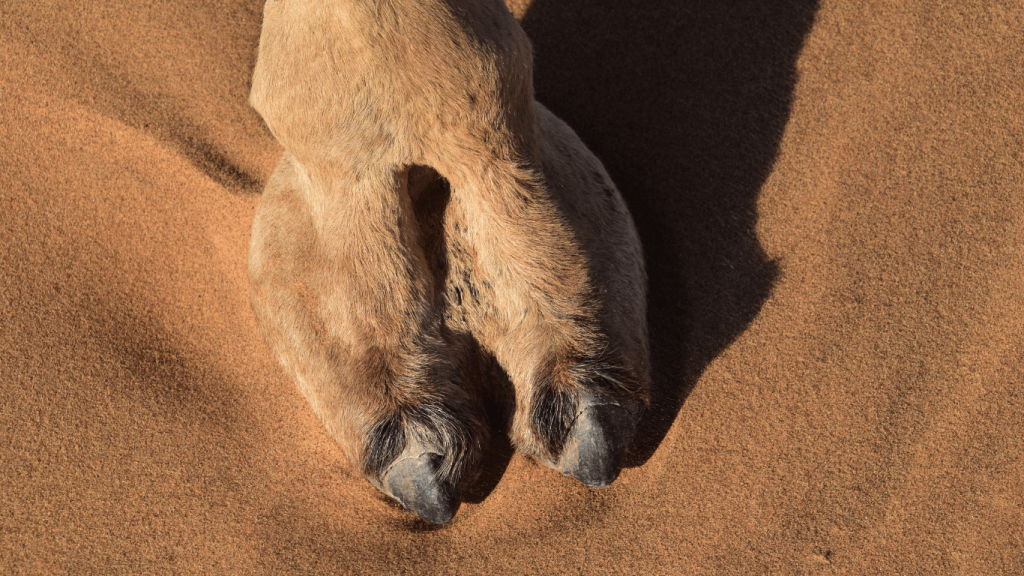
Camels’ feet are broad and tough, allowing them to walk easily over sand without sinking. This characteristic is another adaptation to their desert environments.
Fact 16: Camel’s Digestive System
Camels are ruminants, like cows, meaning they have a specialized stomach that allows them to regurgitate and chew their food twice for easier digestion.
Fact 17: Fast Runners
Despite their bulky size, camels can run at speeds up to 40 mph in short bursts, and maintain a pace of 25 mph over longer distances.
Fact 18: The Use of Camel Hair
Camel hair is used to make clothing and textiles. The soft undercoat is shed annually and collected to be spun into yarn.
Fact 19: Camel’s Copious Saliva
Camels produce large amounts of saliva, especially when they chew their food. This saliva helps in the digestion process and keeps them hydrated.
Fact 20: Heavy Load Bearers
The strength of these incredible creatures is evident in their capacity to transport heavy burdens, up to 900 pounds, for a stretch of 25 miles within a day.
Their strength and endurance have made them indispensable for transportation and carrying goods.
Fact 21: Camels’ Social Structure
Camels are social animals, often found in groups called ‘caravans’ or ‘herds.’ They establish strict hierarchies within these groups, with a dominant male leading the herd.
Fact 22: Camels and Humans
Human interaction with camels spans several millennia, with these creatures having been tamed and utilized by mankind for countless generations. They have served as a source of milk, meat, wool, and transport, making them an integral part of human civilization.
Fact 23: Predators of Camels
While adult camels have few natural predators due to their size, young camels can be targeted by predators such as wolves and lions.
Fact 24: Camels’ Sleeping Patterns
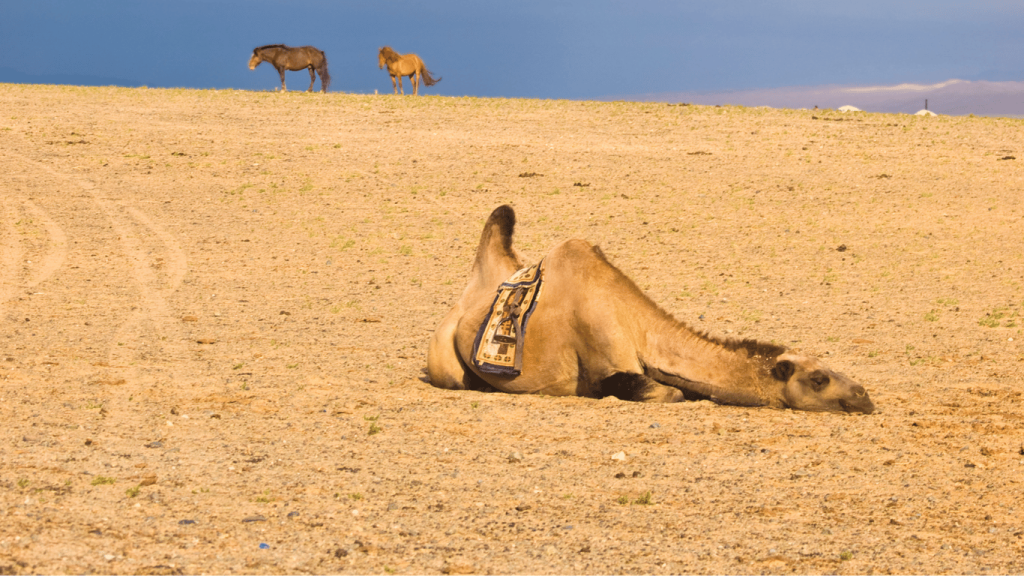
Camels typically sleep with their legs tucked under their bodies. They can sleep standing up and usually sleep for about six hours a day.
Fact 25: Camel Communication
Camels communicate using a variety of sounds, including grunts, roars, and bellows. Not limited to vocal communication, camels also utilize physical gestures as a means of conveying their feelings and sentiments.
Fact 26: Camels in Warfare
Camels have been used in warfare for thousands of years, from the Persian wars to more recent conflicts. Their ability to traverse harsh terrains has made them valuable assets in warfare.
Fact 27: Camels as Symbols
In many cultures, camels are seen as symbols of patience, tolerance, and endurance due to their ability to travel long distances in harsh conditions.
Fact 28: Camels’ Age of Maturity
Camels reach sexual maturity around the age of 3-4 for males and 3-5 for females. This is when they begin to reproduce and contribute to the growth of their herd.
Fact 29: The Camel’s Diet
Camels are herbivores, eating a variety of plants, including grasses, leaves, and even thorny plants. Their tough mouths allow them to eat vegetation that other animals might avoid.
Fact 30: Camels and the Environment
Camels have a low impact on their environment. They consume less water and food compared to other similar-sized mammals and produce less methane, a greenhouse gas.
Fact 31: Camel’s Unique Nose
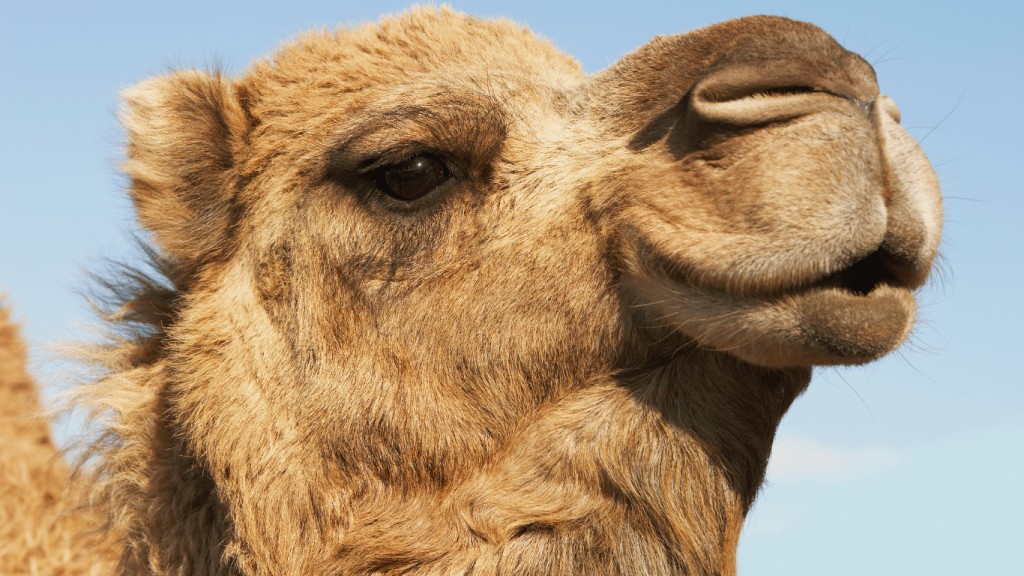
The camel’s nostrils can close completely to prevent sand and dust from entering their respiratory system, an essential feature for surviving in dusty desert conditions.
Fact 32: The Weight of a Camel
The average weight of a camel depends on its species. Dromedary camels can weigh between 880-1320 pounds, while Bactrian camels can weigh up to 2200 pounds.
Fact 33: Camel Racing
Camel racing is a popular sport in the Middle East, particularly in countries such as UAE, Saudi Arabia, and Qatar. Camels can reach high speeds, making these races exhilarating spectacles.
Fact 34: Importance of Camels in Religion
In the Islamic faith, camels are considered a gift from Allah. They’re often involved in religious ceremonies and are mentioned several times in the Qur’an.
Fact 35: Camel Meat

Camel meat is a significant source of protein in many Middle Eastern and African diets. It is leaner and healthier than beef and is often prepared in stews or roasts.
Fact 36: Camels Can Swim
Although they live in arid environments, camels are capable swimmers. This ability helps them cross rivers or bodies of water when migrating.
Fact 37: Camels’ Sense of Direction
Camels have an excellent sense of direction and can navigate over long distances, even in the absence of clear visual landmarks. This has made them invaluable for trade routes and travel in desert areas.
Fact 38: Color of Camels
Camels come in a variety of colors, from light beige to dark brown, depending on their species and genetics. The color of their coat helps them blend in with their surroundings and protect against the sun.
Fact 39: Camels in Popular Culture
Camels have a significant place in popular culture, appearing in books, movies, cartoons, and as plush toys. They are often portrayed as patient, resilient animals with a knack for surviving in harsh conditions.
Fact 40: Adaptation of Camels to Desert Heat
Camel bodies are designed to prevent overheating. They can withstand a body temperature increase of up to 6°C before they start to sweat, conserving water in hot desert climates.
Fact 41: Camel Milk Production
A lactating camel can produce around 4-5 liters of milk per day and up to 20 liters in favorable conditions. This milk is a vital food source for desert-dwelling communities.
Fact 42: Importance of Camels in Tourism
Camels play a significant role in tourism in many desert countries, where camel rides are a popular attraction. Tourists can experience the unique gait and height of these animals, offering an unforgettable experience.
Fact 43: Height of a Camel
An adult camel stands between 1.85 and 2.15 meters tall at the shoulder. When we include the hump, their height can reach up to 2.3 meters.
Fact 44: Camels and Water Conservation
Camels are masters of water conservation. They can reduce their water needs by concentrating their urine, reabsorbing water from their feces, and using their nose to trap moisture from their breath.
Fact 45: The Use of Camel Dung
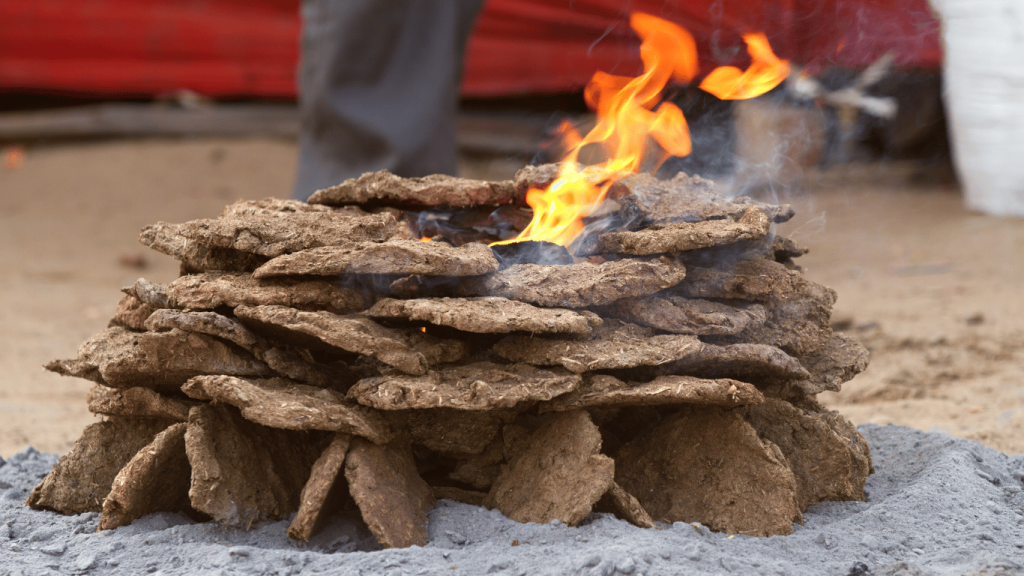
Camel dung is used as a fuel source in some cultures. It is dry and burns easily, making it an effective alternative to wood or other fuels.
Fact 46: Camels Spit
Yes, camel do spit! This behavior is primarily a defense mechanism. When camels feel threatened, they can regurgitate their stomach contents and project them as a form of defense. This isn’t saliva but rather a mixture of stomach fluids and partially digested food. It’s not their preferred form of communication, but it certainly sends a clear message!
Fact 47: Camel’s Unique Antibodies
Camels, along with llamas and alpacas, have unique, smaller antibodies compared to other mammals. This trait has sparked interest in medical research for potential use in immune therapies.
Fact 48: Camels and Climate Change
Camels are expected to play an increasing role in food security, especially in regions where climate change makes the environment hotter and drier. Their resilience to harsh conditions and lower water and food requirements position them as ideal animals for such climates.
Conclusion: Understanding Our Camel Companions
With these 48 top facts about camels, you now have a comprehensive understanding of these fascinating creatures. These amazing facts highlight their adaptability, strength, and significant contribution to human societies over the centuries. As climate change continues to impact our world, camels may become increasingly essential to our livelihoods.
From their distinctive humps, unique physiology, and ability to thrive in extreme environments to the surprising fact that camels do spit when threatened, camels are truly one-of-a-kind creatures. Their enduring presence in our landscapes and cultures is a testament to their resilience and the incredible role they play in the intricate web of life on Earth. Understanding and appreciating camels is more than an exercise in trivia; it is a step towards recognizing the diversity and adaptability of life on our planet.
So, the next time you see a camel, whether in person, in a movie, or in a photo, you’ll be able to appreciate just how incredible these ‘ships of the desert’ really are.

